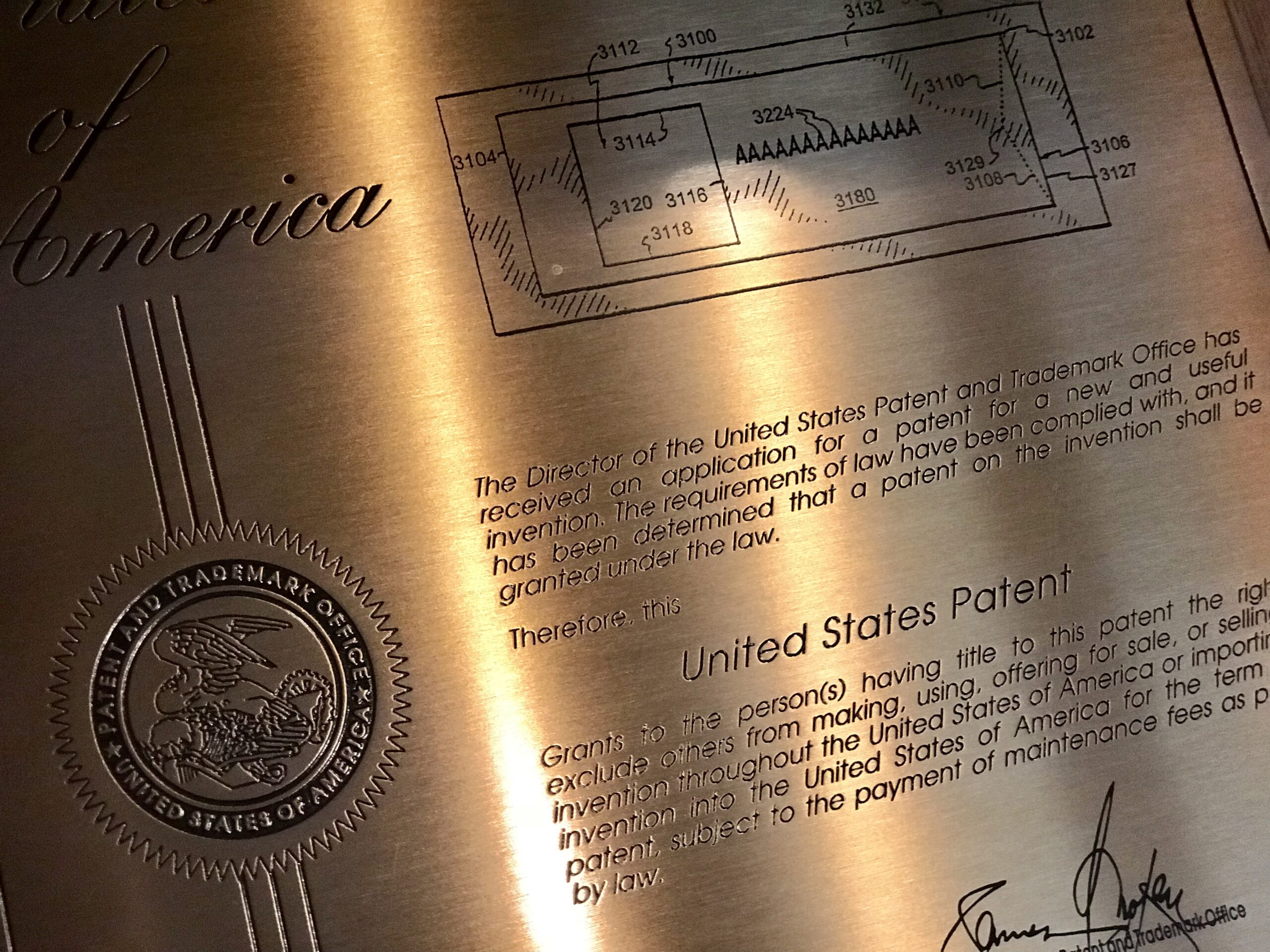In Part 1 and Part 2 of this article about writing patent claims, we challenged you to write a set of claims for a simple skateboard, including the optional features of a “grippy” top surface and a front headlight. How’d you do? Did you get all the elements required for a simple skateboard, namely the base, the trucks, and the wheels?
When writing claim 1 of a patent application, I like to start with the element that is the most fundamental part of the invention, which in the case of a skateboard would be the elongated base or platform. We need to know what areas of the elongated base we’re going to be attaching things to or talking about when introducing an element.
So, the first part of claim 1 might read something like this:
1. A vehicle for a person to ride along a ground surface, comprising an elongated base having a top side, a bottom side, and a peripheral edge, the elongated base further including a front end and a rear end.
Notice that in the preamble we’ve defined a person and a ground surface, both of which are not part of the actual invention but provide context that will be useful later since we’re going to want to discuss how a person rides the device and how the wheels contact the ground surface.
The elongated base is now ready to have things attached to it, namely… a pair of trucks, each truck having a baseplate configured for mounting with the bottom side of the elongated base and an axle having two opposing ends each projecting laterally away from the baseplate, a forward truck of the pair of trucks mounted proximate the front end of the elongated base, and a rearward truck of the pair of trucks mounted proximate the rear end of the elongated base.
It might be argued that no one knows what a “truck” is since this is a new invention, so we’ll need to define it thoroughly in the specification and, most importantly, in the drawings. You’ve heard the adage that a picture paints a thousand words, but in patents, I like to think that a good drawing paints two thousand words, meaning that ample and clear drawings are extremely important.
The following is a bottom view of the skateboard, but we would also want to show a bottom perspective view, and ideally an exploded bottom perspective view, to show all the elements and each part of each element that we’re discussing and how they fit together.

Also, for this simple example, I don’t expect you to deal with rubber bushings that allow the axles of the truck to pivot with respect to the baseplate to facilitate steering, but you can certainly add those as a separate exercise if you’d like to give it a shot. It gets a little tricky when talking about the axles since it could be that each truck has a single axle with two opposing ends, as we’ve written above, or two separate but co-aligned axles, each with distal ends and each with proximal ends fixed with the baseplate.
For simplicity, we’re just dealing with the first option in this exercise, but this shows you that as a writer of patent claims, you need to consider all the different embodiments so that your claims are difficult to break.
Now let’s add the wheels…
Each end of each axle is configured for receiving thereon one wheel, each wheel including a central bearing having an aperture there through for receiving the end of the axle and a peripheral surface configured for contacting the ground surface and for rotating about the bearing.
Question: How do we know how the trucks and wheels are oriented?
There is a front truck and a rear truck, so we know one truck is in front of the other truck. But that doesn’t tell us where the wheels are pointing! What if one truck is mounted at 90 degrees with respect to the other truck? That wouldn’t work very well as a skateboard, and so we might want to add the phrase “all wheels aligned for rotation along the ground surface in a common direction,” or “both axles being orthogonal to a longitudinal axis of the elongated base,” or the like. It will be clear from the drawings, but as long as it doesn’t add an undue limitation, it doesn’t hurt to mention things like this. (Naturally, if we add a provision for steering of the wheels when leaning left or right on the board, the axels won’t be parallel, so we’ll need to rework the claim if we add that feature.)
One main reason for doing this is because the patent examiners will take the broadest possible interpretation of the claims when looking for prior art (previous patents and products that are publicly available at the time of filing) to use against you. If you claim something so broad that it could include a whole area of technology that you aren’t worried about competing against, then you would want to refine your claims to be more specific (since more specific claims in this case won’t hurt you).
For example, if we weren’t clear enough about how the wheels are aligned, then a four-wheel moving dolly might be used against us as prior art. In such a moving dolly, the wheels can rotate forward or backward, but they can also spin 360 degrees with respect to each other independently. We don’t care about competing with moving dollies, so if we want to make sure moving dollies won’t be used against us when the patent is examined, we will need to ensure that all four wheels are commonly aligned by stating such in the claims.
We can also add a “whereby clause” at the end of the claim that shows how the product works as a vehicle. The whereby clause doesn’t usually limit the claim, but rather provides context and shows how the product works. Claim 1 now reads:
1. A vehicle for a person to ride along a ground surface, comprising:
An elongated base having a top side, a bottom side, and a peripheral edge, the elongated base further including a front end and a rear end; a pair of trucks, each truck having a baseplate configured for mounting with the bottom side of the elongated base and an axle having two opposing ends each projecting laterally away from the baseplate, a forward truck of the pair of trucks mounted proximate the front end of the elongated base, and a rearward truck of the pair of trucks mounted proximate the rear end of the elongated base; and each end of each axle is configured for receiving thereon one wheel, each wheel including a central bearing having an aperture there through for receiving the end of the axle and a peripheral surface configured for contacting the ground surface and for rotating about the bearing, each wheel aligned with each other wheel for rolling along the ground surface in a common direction; Whereby, with the wheels contacting the ground surface, the person stands on the top surface of the elongated base to ride the vehicle along the ground surface.
Personally, I’m still not happy with this claim, as it’s relatively long and there are probably still some holes in it. I’m sure all of my fellow patent practitioners will want to comment on how this claim could be improved, as critiquing someone else’s claims seems to be our favourite pastime. But as is famously said about writing, if I had had more time, it would have been shorter.
Adding the “grippy” texture to the top surface as a dependent claim is easy.
2. The vehicle of claim 1 further includes a high-friction surface applied to at least a portion of the top side of the elongated base.
We’ll need to define what a “high-friction” surface is in the specification, complete with examples of actual products such as grit-encased epoxy tape used for a non-skid surface on stairs or the like. The more examples of such things you can add to the specification, the better, since it will broaden the interpretation of “high-friction surface” used in the claims. Technically, the term “high friction” is somewhat subjective and indefinite, so if you can lock that in with examples of what you mean in the specification, perhaps even to the point of specifying an amount of grit of a particular size per square inch,
Adding the headlight is also fairly straightforward.
3. The vehicle of claim 1 further includes a headlamp assembly fixed with the elongated base proximate the front end of the elongated base, the headlamp assembly including an enclosure for housing a lamp, an electric switch, and a battery, whereby when the switch is closed, the lamp illuminates the ground surface in front of the front end of the vehicle.
Notice we’re not adding things like a circuit for flashing the lamp, or what type of lamp it is (incandescent? LED?), or if it has an auto-off feature after a certain countdown time is reached, or if the enclosure has a non-opaque portion for allowing light to escape the enclosure if the lamp is disposed within the enclosure, etc. So there’s certainly more work you could do here.
As an additional exercise, take a look at the claims in patents found during your last patent search and see if you can understand them more clearly now. Print them out and highlight the nouns. This is much more interesting if these patents relate to one of your invention ideas—something near and dear to you.
Or, even better, read through the claims written by your patent practitioner on one of your previous patent applications. You might be surprised at how concisely claim 1 describes what your patent protects, and if you have questions, your patent practitioner should always be willing to dive into the claims and really wrestle with them, making sure they protect everything you want to protect (and nothing that you don’t care about). You will certainly be in a better position now to evaluate a proposed set of claims for your next invention.



